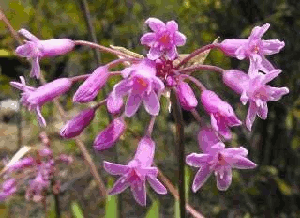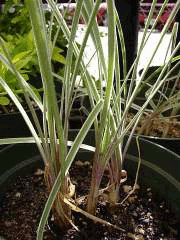Society Garlic
Common Names: Society garlic, wild garlic, sweet garlic, pink agapanthus, spring bulbs, spring flowers.
Scientific Name: Tulbaghia violacea
Climate: Warm temperate and cold.
Plant Description: Society garlic is a fast growing perennial plant up to 50 cm tall, with linear, grayish-green basal leaves. The leaves are characterized by a strong garlic smell when crushed. It has umbels of small star-shaped flowers with a small crown in the shape of a cup. The flowers are tubular, with six petals forming a star, they are fragrant, and pale purple in color. The triangular capsules found on the plant are its fruit. These are also grouped together, forming a distinctive head. When they are ripe, they open and release their seeds for natural propagation.
Society Garlic is native to South Africa.
Cultivation: It needs to be planted in full sun; it tolerates semi-shade but flourishes less. It adapts to a wide variety of soil types. It prefers sandy, drained, deep and well-fertilized soils.
It can reproduce by seeds or from a bulb-shaped root. The multiplication by seeds is done in trays or seedbeds and is transplanted to its final place one year after sowing.
Propagation: It is better to separate the clumps in spring or fall. To divide them, trim the upper part, lift the plant, cut the roots and separate the pieces. Divide the manageable sections so that you have only individual plants, make sure there is a root attached to the plant. You need to cut half of the foliage to reduce the impact of the plant. Prepare 15 cm diameter pots by filling them with natural compost up to half. Place the plant in the pot and fill gently so as not to hurt the roots. Water the plants. The pots can be put outside, just make sure to keep them moist. It can be transferred to well fertilized soil in 3 months. Plants should be 20 cm apart. Cover the tuberous roots with 2 cm of soil. They should be left as long as possible without moving or disturbing them. Water them regularly so that the soil is moist but not waterlogged. The first flowers appear two or three years after planting.
You can also plant the cut bulbs directly to the ground just below the soil surface leaving the 20 cm distance between the plants and watering them well.
The division of the plan every few years improves the vigor of the bushes.
Uses: The spicy leaves can be used as garlic in salads and other dishes. The flowers are on the sweet, spicy, onion-like side. The  bulbs, however, are more medicinal although in some parts of the world they are consumed as vegetables. The plant has been shown to have antibacterial, anti-fungal, and anti-thrombotic properties. The leaves are used for esophageal cancer and sinus headaches. It is also used to cure tuberculosis, to fight earthworms and intestinal parasites, to cure coughs, and colds. When planted around the house, society garlic keeps snakes, mosquitoes, ticks, and fleas away. It is used to repel pests in the garden. The crushed leaves can be used to drive away gophers in the garden.
bulbs, however, are more medicinal although in some parts of the world they are consumed as vegetables. The plant has been shown to have antibacterial, anti-fungal, and anti-thrombotic properties. The leaves are used for esophageal cancer and sinus headaches. It is also used to cure tuberculosis, to fight earthworms and intestinal parasites, to cure coughs, and colds. When planted around the house, society garlic keeps snakes, mosquitoes, ticks, and fleas away. It is used to repel pests in the garden. The crushed leaves can be used to drive away gophers in the garden.
Pests and Diseases: Society garlic is not sensitive to any particular pest and is rarely infected by it. Their main enemy are snail caterpillars and slugs that cause serious damage to the foliage but do not kill the plant.
References:
https://plants.ces.ncsu.edu/plants/tulbaghia-violacea/
